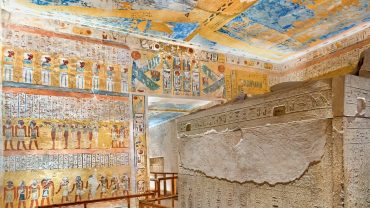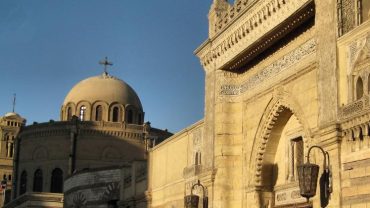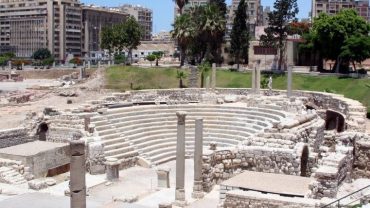Tomb of Seti I in the Valley of the Kings | KV 17 | History, Facts, discovery, Pharaonic Tombs, ancient Egyptian history | Egyptian Pharoah
Who is Seti I? Facts About King Seti I (1290 to 1279 BC)
Seti I was the second Pharaoh on the throne of Egypt in Nineteenth Dynasty of Egypt during The New Kingdom of Ancient Egypt. Menmaatre Seti I was the son of father Ramesses I and Queen Sitre and the father of Ramesses II. His first wife was Tuya, who was the daughter of a high-class man. His first son died young, but his second son was Ramesses II. The Pharoah had two daughters one called Tia while the second was Henutmire who would become a minor queen of Ramesses II.
Pharaoh Seti I is well known for his set policy of major building at home and a committed foreign policy. His reign marked the greatest in regard to art and culture. However, the quality of the reliefs and other designs was never compared to what the Egyptian Pharaohs did later.
His great and remarkably well-preserved Abydos temple is still one of the top Luxor tourist attractions. Besides, his tomb in the Valley of the Kings, KV17 is one of the best things to do in Luxor and a perfect example of Pharaonic Tombs.
Where is Seti I, Tomb?
The tomb of Seti I, KV17 is located in the main Valley of the Kings, Luxor East Bank of the Nile, Egypt. KV17 is side by side with the tomb of Ramesses I is KV16 and almost faces the tomb of Tutankhamun.
Facts about the King Seti I tomb KV17, Valley of the Kings, Luxor, Egypt
- The tomb of Seti I at the Valley of the Kings is the deepest, longest, and finest among the Pharoah’s tombs in Luxor.
- The tomb carries the Number KV 17 means it was the tomb number seventeenth discovered in the Valley of the Kings
- Giovanni Battista Belzoni discovered the tomb of Seti I in October 1817
- The tomb of Seti I (Sethos I) is the longest tomb more than 137 meters deepest and the most completely finished in the Valley of the Kings.
- The tomb is also known as Belzoni’s Tomb, the Tomb of Apis, and the Tomb of Psammis
- Seti I tomb has most of the religious books from Ancient Egypt such as the Litany of Ra, Book of the Dead, Imydwat, Book of Gates, the Opening of the Mouth Ritual, and the The Book of the Heavenly Cow.
- One of the oldest Royal Tomb in the Valley of the Kings decorated through all passages and chambers
- KV 17 contained a mummified bull mummy in one of the side chambers representing God Apes
Who discovered the tomb of Seti I KV17?
Seti I’s tomb is located between the tomb of his father, Ramses I, and that of Ramses X. Meanwhile, Giovanni Battista Belzoni discovered KV 17 in October 1817.
Restoration work in the tomb of Seti I
The tomb suffered a lot from the deterioration of the decoration, pillars, walls, and ceilings because of the humidity, dust, and dirt. All this led to the closure of the tomb in order to constrain further destruction.
1960 the ceiling of some chambers was shored with wood members.
in 1981 they added a steal frame to support the ceiling in some chambers
they added an arched steel frame in 1990 to support the astronomical ceiling
Restoration work in the tomb of Seti I by Laura and Paolo Mora started in 1999
We can conclude that after the tomb was opened to the public, air circulation increased, and humidity changed due to respiration and transpiration from tourists.
The plan of The Tomb of Seti I KV 17| Tomb Layout
First of all, to reach the tomb of Seti I at the Valley of the Kings, you need to cross the entrance where they check your ticket. Then, walk straight into the main Valley like 400m, it will be the 2nd tomb on your left-hand side facing Tutankhamun’s tomb.
- Entryway
- Gate B
- Corridor B
- Gate C
- Stairwell C
- Gate D
- Corridor D
- Gate E
- Well chamber E
- Gate F
- Pillared Chamber F
- Descent F
- Gate Fa
- Side Chamber Fa
- Gate G
- Corridor G
- Gate H
- Corridor H
- Gate I
- Chamber I
- Gate J
- Burial Chamber J
- Side Chamber Ja
- Gate Ja
- Gate Jb
- Side Chamber Jb
- Gate Jc
- Gate Jd
- Side Chamber Jd
- Gate Je
- Side Chamber Je
- Corridor K
The inscriptions & decorations | Tomb reliefs
First of all, to reach the tomb of Seti I at the Valley of the Kings, you need to cross the entrance where they check your ticket. Then, walk straight into the main Valley like 400m, it will be the 2nd tomb on your left-hand side facing Tutankhamun’s tomb
Entryway
26 steps leading to the entrance of the tomb
Gate B
The names and the titles of the King on the southeast side
Corridor B
The ceiling of this corridor like the main corridor in Dendera Temple and most of the Pharaonic temples is decorated with the winged vulture symbol of protection.
The walls are decorated with high reliefs that show Seti I before God Ra-Horakhty then both sides show the scenes from the Litany of Ra.
Gate C
Gate C is decorated with the winged sun disc and thicknesses are covered with texts of the Litany of Ra
Stairwell C
The walls of the stairwell are decorated with the Litany of Ra and the third hour of the Imydwat. While, the rest of the walls show God Anubis, ISIS, Nephthys, and Maat as winged Goddesses.
Gate D
Two seated goddesses Maat flanking, protecting the names of the king Seti I, and two Baboons from the Imydwat.
Corridor D
A sloping corridor decorated with the fourth and fifth hours of the Imydwat
Gate E
Like most of the gates, gate E is decorated with the names and titles of the Pharoah Seti I and the winged sun disc.
Well chamber E
The ceiling of the well chamber is decorated with stars on a blue background imitating the sky. The reliefs here show Seti I offering wine to Hathor, in front of Osiris, led by Anubis.
Gate F
Again, the winged sun disc and the names of the Pharoah.
Pillared Chamber F
A square room with 4 pillars covered with scenes from the Book of the Gates, and the King with different deities such as Horus, Osiris, and Hathor.
Descent F
Is not decorated
Gate Fa
The Book of the Gates and the Imydwat decorated the gate walls.
Side Chamber Fa
The walls of this chamber are decorated with the ninth, tenth, and eleventh hours of the Imydwat.
Gate G
The gate scenes are moved to Louvre and Florence by Champollion and Rosellini
Corridor G
The walls are decorated with texts and scenes from the Opening of the Mouth ritual
Gate H
Door jambs are decorated with scenes from the Opening of the Mouth ritual
Corridor H
Opening of the Mouth ritual and Litany of the Eye of Horus while the ceiling is decorated with yellow stars on a blue background.
Gate I
Again, the winged sun disc on the lentils and the names of the Pharoah.
Chamber I
All the scenes show the king with the Gods and the ceiling decorated with stars.
Gate J
A repeated scene for the winged sun disc and the cobra goddesses Nekhbet and Wadjet.
Burial Chamber J
vaulted ceiling with 6 pillars and some side chambers. Imydwat, Book of the Gates decorate the walls. Ceiling with astronomical figures
Side Chamber Ja
The Book of the Gates scenes cover the walls
Gate Ja
The King and his Ka are the main scenes
Gate Jb
Goddess Nekhbet and Wadjet as cobras over the plants of Upper and Lower Egypt
Side Chamber Jb
A room with two pillars is decorated with different hours scenes from the Imydwat
Gate Jc
Carter built that gate in modern times
Gate Jd
The thicknesses of the gate carrying scenes for the Djed Pillars
Side Chamber Jd
Undecorated chamber
Gate Je
The reliefs for Seti I offer boxes of colored cloth
Side Chamber Je
Scenes from the Book of the Heavenly Cow
Corridor K
In this corridor, Belzoni found the sarcophagus of Seti I, now in Soane’s Museum, London.
Measurements
- Maximum height: 6.05 m
- Minimum width: 0.66 m
- Maximum width: 13.20 m
- Total length: 137.20 m
- Total area: 649.04 m²
- Total volume: 1900.36 m³
Decoration of the tomb of Seti I
- Painting
- Raised relief
Things found inside the tomb of Seti I
- Bull Mummy
- Tomb equipment
- Vessels
- Writing equipment
Tomb Robberies at the End of the New Kingdom
Tomb robbing in ancient Egypt was recognized as a serious problem since antiquity. The tomb of Tutankhamun gave us a perfect example of what we can find inside a royal tomb. That was the reason why the tombs were targeted for tomb robberies right after burying the kings.
Visiting Hours of KV17?
As long as the tomb of Seti I is one of the Valley of the Kings’ tombs, the visiting hours to KV 17 are the same as the opening hours of the Valley of the Kings. Valley of the kings is open daily from 06.00 am to 17.00 pm but ticket windows close at 16.30 pm. That means you can visit the tomb daily between 06.00 am to 17.00 pm.
How much is Seti I tomb ticket?
kindly put in your mind that you will need to purchase two tickets. Entrance ticket for the Valley including access to 3 tombs and a ticket for the electric car. Ticket windows are next to each other. The entrance ticket includes 3 opened but Seti I tomb needs an extra ticket that costs 1400 L.E
Tips for visiting the tomb of Seti I
- The first piece of advice we can tell, visit the valley of the Kings and the tomb of Seti I with an archaeologist guide. They will provide you with a detailed explanation of the development of the tombs from the Predynastic period till the New Kingdom. Meanwhile, detailed information about the Pharaonic tombs and ancient Egyptian history during the New Kingdom.
- Read before you go to enjoy more
- Take extra water with you and some snacks, especially in the summer months, and drink at least 5 small bottles of mineral water to not hydrate.
- Small change for the WC (5 L.E) per person
- Do not forget to take your hat, sunglasses, and suncream with you
- Cotton dress during summer
- There is a café facing king Tutankhamun’s tomb in the valley of the kings if you like to drink something or have an ice-cream
Kindly Note:
That was a brief idea about the tomb of one of the ancient Egyptian Pharaohs and an example of one of the Pharaonic tombs in the Valley of the Kings. If you like to visit more Pharaonic tombs and learn more about the best things to do in Luxor, Egypt Goota Travel highly recommends Luxor Tours to
- KV2 The Tomb of Ramesses IV
- KV6 The Tomb of Ramesses IX
- KV11 The Tomb of Ramesses III
- KB 8 Merenptah tomb
- KV 14 Tausert and Setnakht
If you like to know about the best tombs you can visit against the charge, here are the three extra ones
- KV9 – Ramesses V, Ramesses VI
- KV62 – Tutankhamun
That was about the Valley of the Kings and the Pharaonic tombs but if you like to know more about Egyptian History when booking Luxor Day Tours from Hurghada. If you like to learn more about Ancient Egyptian civilization, and Pharaonic temples, we recommend the following sites




Comment (0)